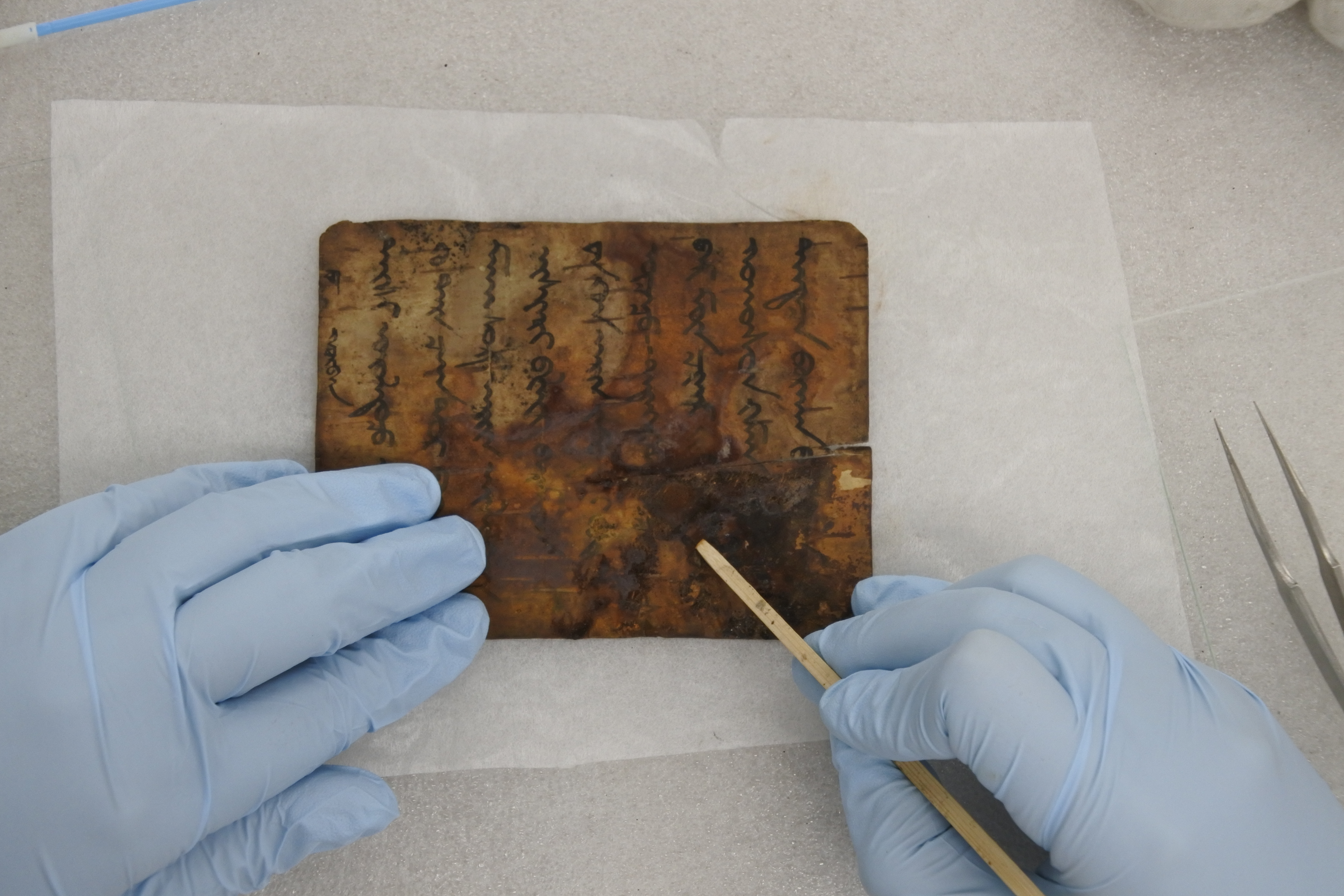The Completion of Conservation Treatment
in National Research Institute of Cultural Heritage, Korea for Buddhist Scriptures
Made of Bark around the 17th Century
by Request of Mongolia
- Supported by 「Arrangement on the Korea-Mongolia Joint Project
for Research and Preservation of Cultural Heritage」 -
- Successful restoration similarly to the original shape for damaged letters,
identifying the manufacturing process and letters on the Buddhist scripture -



The Cultural Heritage Conservation Science Center (CHCSC, Director, Jeong Soyoung) in the National Research Institute of Cultural Heritage (NRICH) under the Cultural Heritage Administration (CHA) of Korea completed the conservation treatment for Buddhist scriptures around the 17th century which had been requested by the Institute of History and Archaeology, Mongolian Academy of Sciences (MAS) from Mongolia.
This conservation treatment was requested by the Institute of History and Archaeology under the MAS in 2019 to NRICH for Buddhist scriptures which had been excavated from the architectural historic site, Sum Tolgoi in Tes soum of Zavkhan aimag(province) located in the west from Ulaanbaatar, the capital city of Mongolia, where the excavation had been underway as the project on ‘Cities of Mongolia in the 17th century’ led by Director, CHULUUN Sampildondov (who is the incumbent Minister of Culture, Mongolia) in charge of the Institute of Archaeology at that time of 2018~2019. Artifacts which were sent to NRICH for conservation treatment are 21 items including Buddhist scriptures written in Mongolian and Tibetan languages on bark and paper.
* Sum Tolgoi: A structure in a style of Tibet, built by the Khutagt (who means a living Buddha and high priest) around the 17th Century



The support for this conservation treatment was one part of ‘Arrangement on the Korea-Mongolia Joint Project for Research and Preservation of Cultural Heritage’ (signed by both institutes in 2019), and the practical work of conservation treatment based on the scientific analysis was carried out by the CHCSC in NRICH, Korea.
Buddhist scriptures excavated from dry soil were torn to several pieces or crumpled, and letters on their surfaces were unrecognizable by attached pollutants. Accordingly, the CHCSC removed pollutants by applying adequate moisture and took a step for unfolding. For tears of Buddhist scriptures made of paper, they were strengthened with restoration paper made from Dak tree, the paper mulberry of Korea, and cut surfaces of Buddhist scriptures made of bark were joined with cellulose resin or consolidated. Through the conservation treatment, letters were clearly identified, and areas damaged by tears and crumpling were restored similarly to the original shape, which resulted in restored condition to the extent that letters are as legible as that contents in the Buddhist scriptures can be identified.

Furthermore, the basic data for research on those Buddhist scriptures was secured from infrared images of clearly identified letters, and from the component analysis it was found out that the pigment containing ink, Ag(silver), Fe(iron) had been used for writing ink. In particular, by radiocarbon dating for Buddhist scriptures made of paper, the data of absolute ages around the 15~17th century was acquired, and it was confirmed that base paper was dyed in indigo and then letters were written in the manufacturing process.
Based on results from conservation treatment and scientific research which were conducted in Korea, further research on contents and interpretations on those Buddhist scriptures is being carried out by the Institute of History and Archaeology in MAS. Subsequently, the publication of its report is planned after those artifacts are returned to Mongolia, and exhibitions for utilization are expected.

This year the joint research between both institutes will be continued. Taking this opportunity, the National Research Institute of Cultural Heritage under the Cultural Heritage Administration of Korea will try to newly prepare the plan for educational support human resources who are engaged in conservation treatment for organic materials relatively in inadequate environments to solidify amicable cultural relations between both countries.
몽골 출토 17세기 나무껍질에 쓴 불교경전, 한국에서 보존처리
몽골 출토 17세기 나무껍질에 쓴 불교경전, 한국에서 보존처리
문화재연구소, 몽골서 의뢰한 17세기 불교 경전 보존처리 완료 임동근 기자 / 기사승인 : 2021-01-27 10:53:10 경전 글씨와 제작과정 확인…손상된 글자 원형에 가깝게 복원 k-odyssey.com/news/newsview.
historylibrary.net
'NEWS & THESIS' 카테고리의 다른 글
| 멸종위기로 가셨다는 아마존 민물돌고래 투쿠시 Tucuxi (0) | 2021.01.28 |
|---|---|
| 국제자연보존연맹IUCN 2020 회의는 2021년 11월 마르세이유에서 (0) | 2021.01.28 |
| 몽골 출토 17세기 나무껍질에 쓴 불교경전, 한국에서 보존처리 (0) | 2021.01.27 |
| Queen Mother of the West returns from the US in 50 years (0) | 2021.01.27 |
| Natural Inorganic Pigments in Korea (0) | 2021.01.26 |




댓글